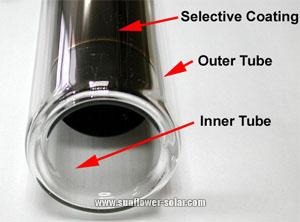Solar Evacuated Tubes
The absorbers of the solar water heaters are evacuated tubes. They can transform the solar energy into heat for the water heating. Evacuated tubes have already been used for many years in Germany, Canada, China and the UK. There are several types of evacuated tubes for the solar industry. Sunflower collectors apply the most common "twin-glass tube". Because of its reliability, good performance and low-cost for production.

The twin-glass tubes are made from extremely strong borosilicate glass for each evacuated tube. The outer tube is transparent, for the purpose of allowing the light ray to pass through and reducing the reflection of light ray to the minimal. The inner tube is coated with a layer of special selective coating (Al-N/Al) with excellent solar radiation absorption and minimal reflection, which greatly improve the efficiency of soalr energy absorbance. The top of the two tubes are fused together and the excess air in the space between the two layers of glass is pumped out by exposing the tube in high temperature. This "evacuation" of the space of glasses forms a vacuum, which is an important feature for the good performance of the evacuated tubes.
Please
Why a vacuum?
As you may use a glass lined thermos flask before, vacuum is a insulator with good performance. This is important because we don't want to lose the heat which convert by the evacuated tube from sunshine !! The vacuum can help to achieve this. The insulation properties are good when the inside of the tube may be 150oC / 304oF , the outer tube is cold to touch. This means that evacuated tube water heaters can also perform well even in cold weather while flat plate collectors perform poorly due to heat loss (during high Delta-T conditions).
In order to maintain the good performance of vacuum, there is a barium getter between the two glass layers (the same as in television tubes). During manufacturing of the evacuated tube, this getter is exposed to high temperatures and form a pure layer of barium on the bottom of the evacuated tube. This barium layer can efficiently absorb any CO, CO2, N2, O2, H2O and H2 out-gassed from the evacuated tube during storage and operation, in order to good performace of vacuum. The barium layer also provides a clear visual indicator of the vacuum status. The silver coloured barium layer will turn white if the vacuum is broken. This makes it easy to distinguish whether a tube is in good conditionor not. You can refer to the pictures below.
 |
 |
|
The Getter is located at the bottom of the evacuated tube. |
Left Tube = Vacuum Present
Right Tube = Faulty |
Evacuated tubes are aligned in parallel, the angle of mounting depends on the latitude of your location. In a North South direction the tubes can passively track heat from the sun all day. In an East West direction they can track the sun all year round.
The efficiency of a evacuated water heater depends on a number of factors, one important is level of evacuated radiation (insolation) in your region. To learn more about insolation and the average values of your area click here.
Evacuated Solar Collector Tube Technical Specifications:
|
Length |
1500mm |
1800mm |
|
Outer tube diameter |
47mm |
58mm |
|
Inner tube diameter |
37mm |
47mm |
|
Weight |
1.3kg |
2.2kg |
|
Glass thickness |
1.6mm |
1.6mm |
|
Material |
Borosilicate Glass 3.3 |
Borosilicate Glass 3.3 |
|
Absorptive coating |
Graded A1/N/A1 |
Graded A1/N/A1 |
|
Vacuum degree |
P<5*10 -3 Pa |
P<5*10 -3 Pa |
|
Thermal expansion |
3.3*10 -6 /°C |
3.3*10 -6 /°C |
|
Insolation Temperature |
>200°C |
>200°C |
|
Absorptance |
>93% |
>93% |
|
Emittance |
<8% |
<8% |
|
Heat loss |
<0.8W/(m2°C) |
<0.8W/(m2°C) |
|
Maximum strength |
0.8Mpa |
0.8Mpa |
|
Resist cold |
-35 °C |
-35 °C |
|
Resist hailstone |
Ø 25mm |
Ø 25mm |
|
Resist wind |
30m/s |
30m/s |
|
Start-up temperature |
<=25°C |
<=25°C
|
^ Back to top
